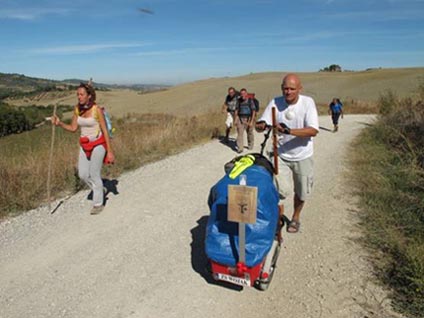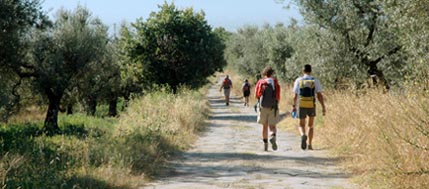| |
 |
The ancient Via Francigena |
|
| The ancient Via Francigena is a pilgrim route starting as far away as Canterbury in England and in a sense is the "mother road" for Christian pilgrims in Europe.
For centuries, pilgrims from across Europe would trek across the Alps using the famous Saint Bernard Passes on their way to the pilgrim churches of Rome. During the Middle Ages, the Via Francigena went further south to the port of Bari, home to the remains of Saint Nicholas and departure point for the Holy Land and the Church of the Holy Sepulcher in Jerusalem. While not as popular or well maintained today as the route to Santiago de Compostela in Spain, the Via Francigena can still be traversed through Italy to Rome on foot for those who want to walk in the footsteps of so many faithful souls before them.
However, a more practical approach may be to combine modern transportation with hiking the better-maintained portions of the original route. Recently the Italian Government has announced plans to promote and refurbish the Via Francigena to bring it up to the level of the pilgrim routes of Santiago de Compostella, Fatima and Lourdes.

Via Francigena Column
Pilgrims traveling on foot will need a detailed map of their route since the Via Francigena is not well marked in many locations. Accommodations reserved for pilgrims along the route are also in short supply as well, most pilgrims end up staying in hotels or private hostels but there are opportunities to sleep in monasteries and convents so long as there is room available.
A Pilgrim Letter or Pilgrim identity card issued by a priest or will usually grant a stay in an Italian monastery or other church facility for at least one night.
The Route through Italy
The pilgrim route gets its name from the fact the route enters Italy from France via the Alpine passes, it roughly translates as "the route of the Franks". The Great and Little Saint Bernard Passes are still used by pilgrims and are the home of mountain hostels built in the 11th Century, famous today for breeding St. Bernard rescue dogs. When these mountain passes are clear of snow, pilgrims make their way into the Val d'Aosta before heading south towards Rome. However, the route to Rome is not a permanent itinerary as there are many deviations depending upon the particular shrines a pilgrim would like to visit. The following itinerary along the Via Francigena are major stopping points, however pilgrims-to-be are not limited to the locations listed here. Pilgrims that are healthy enough and choose to walk the entire route will have many more choices on which towns to stay in and will be able to visit many more churches, monasteries and shrines.

A small part of the Via Francigena Route used by the Pilgrims
Aosta to Pavia
The first major stop on the Italian portion of the Via Francigena is the city of Aosta. This is where pilgrims from the two mountain passes meet up and begin the Italian leg of their pilgrimage. The pilgrims often pray at the Aosta Cathedral and the Church of Sant'Orso before heading out of town to the south.

Settimo Vittone
After leaving Aosta, pilgrims head towards the town of Ivrea. The Cathedral of Ivrea is of special interest to pilgrims since it contains the relics of Blessed Thaddeus McCarthy, whose possibly incorrupt body has performed miracles. From Ivrea the route leads pilgrims to the ancient towns of Santhia and Vercelli. In Vercelli pilgrims should head to the Romanesque/Gothic Basilica of Sant'Andrea, a former Cistercian abbey with a quiet cloister. The Cathedral of Vercelli is dedicated to Sant'Eusebio, an early bishop whose ancient writings as well as many other priceless documents are preserved in the Church's library.
The Via Francigena then heads to the city of Pavia, home to a very old university and some fine churches including a Duomo with the third largest dome in Italy. The basilica of San Michele Maggiore is the most beautiful in Pavia and its crypt contains the tomb of Blessed Martino Salimbene. San Pietro in Ciel d'Oro is of special note since it houses the remains of Saint Augustine of Hippo and Boethius, a late antiquity Christian philosopher put to death by Theodoric the Goth.
 Along the Via Francigena towards Radicofani Along the Via Francigena towards Radicofani
Piacenza to Fornovo di Taro
From Pavia, the Via Francigena's first stop in Emilia Romagna is the city of Piacenza. Pilgrims stop to pray at the church of Santa Maria di Campagna, located in the Piazzale delle Crociate (Crusader's Square), site of Pope Urban II's announcement of the First Crusade in 1095. The Chiesa di Santa Brigida, in Piazza Borgo and the Basilica di Sant'Antonino, known for its octagonal tower are also along the Via Francigena.
The Route heads southeast to the small but once prominent town of Fiorenzuola d'Arda on its way toward Fidenza. Pilgrims are welcome at the church of San Francesco and the Collegiata of San Fiorenzo, which is the main church of Fiorenzuola d'Arda.
The Via Francigena follows the ancient Roman Via Emilia to Fidenza, which was once known as Borgo San Donnino. The Fidenza Duomo is dedicated to San Donnino, the town's patron saint who is said to have picked up his own severed head (similar to Saint Denis), placing it on the future spot of his church.
From Fidenza the Via Francigena heads south to Fornovo di Taro, where pilgrims can pray at the parish church and rest up before taking the Cisa Pass after the town of Berceto in order to cross the Apennines into Tuscany.
 Francigena Settimo Vittone Francigena Settimo Vittone
|
|
|
| |
| |
 |
|
 |
|
Organize
your vacancy courses. |
|
|
 |
|
 |
|
Check
on-line your italian knowledge. |
|
|
 |
|
 |
|
Trace
your price in our list based for
you. |
|
|
|
|
|
 |
| Community of friends that enjoy learning italian from each other's experiences
>>>more
|
|
 |
|
|